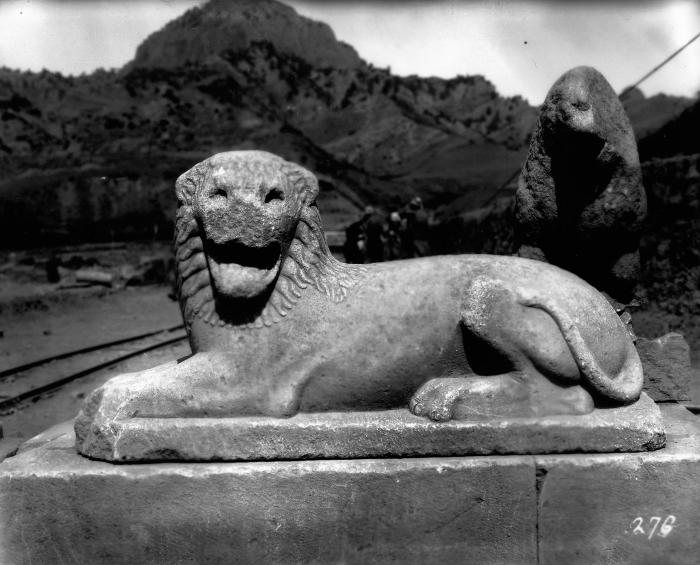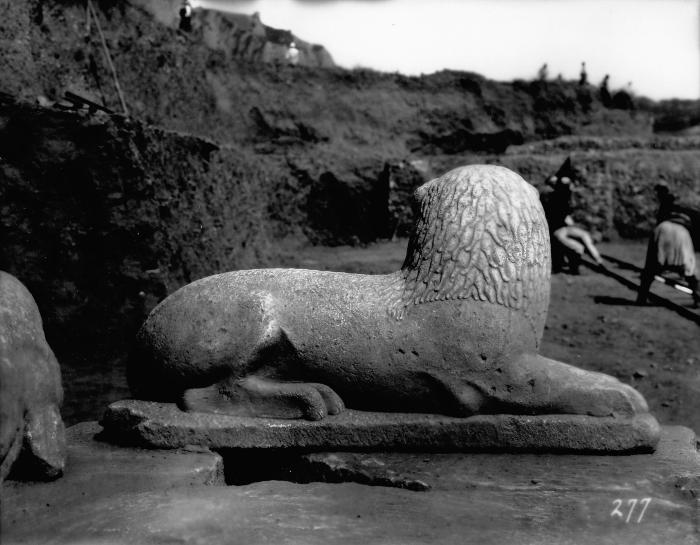Recumbent Lion From Nannas Monument
- Date
- 550-540 BC, Lydian or Late Lydian
- Museum
- Istanbul, Archaeological Museum, 4028
- Museum Inventory No.
- 4028
- Sardis or Museum Inv. No.
- IAM 4028
- Material
- Marble, Stone
- Object Type
- Sculpture
- Sculpture Type
- Animal, Lion
- Site
- Sardis
- Sector
- AT
- Trench
- AT
- Locus
- AT Nannas Monument
- Findspot
- Artemis Precinct, found lying at end of largest pedestal and against smaller one of Nannas monument. It was lying across the short end with feet projecting over the edge (Sardis I, 126 and Shear, Lion, 127, figs. 2, 4, where the lion is restored lying lengthwise on the rectangular, larger, base; cf. Fig. 407, looking E). For Nannas base and reuse by Romans cf.
Cat. 274 (Figs. 465-466) andSardis R1 , 62, 64, 68.
- Description
On a plinth with forepaws extended in front, the lion has its head turned to the l. with the mouth wide open and tongue protruding. The eyes are hollow for inlay, the ears fairly close to the head. The mane is arranged in leaf-like locks, many ending in a small knob; from the back it resembles a kerchief with fringe. The massive forms of the body are smooth and not highly articulated. The tail is looped up and over the proper l. haunch. The piece is apparently by a different hand than Cat. 235 (Figs. 405-406).
Shear drew the persuasive comparison with the Corinthian lions from Loutraki (Gabelmann, Lowenbild, pl. 8, no. 58). Gabelmann has pointed out the differences -the short "back mane" and the Assyrianizing arrangement of the mane and locks. He thought that the golden lion of Croesus in Delphi (Herodotus 1.50) might be envisaged in this posture and pointed out that the inlaid eyes of the Sardis lion are unusual and perhaps conditioned by the imitation of metal technique (cf. also the gold lions, Sardis XIII, no. 86, pl. 8). In the reconstruction proposed by Elderkin (Golden Lion, 1ff., fig. 1) the Delphi lion does not turn his head. A date around mid-6th C. is confirmed by the Loutraki lions. Gabelmann dated the Nannas lion ca. 540 B.C.
- Condition
Marble.
Muzzle and l. forepaw damaged.
- Dimensions
- L. 1.22; H. 0.65.
- Comments
- See Also
- Bibliography
- Published: Sardis I, 127, fig. 138; H. C. Butler, Fourth Campaign, 474f., fig. 4; Shear, Lion, 127ff., figs. 1, 5, 11, 16; Akurgal, Kunst Anatoliens, 279, fig. 245; von Gall, Felsgraber, 588f., fig. 4; Gabelmann, Lowenbild, 82f., 84, 89, 119, no. 109.
- Author
- NHR


